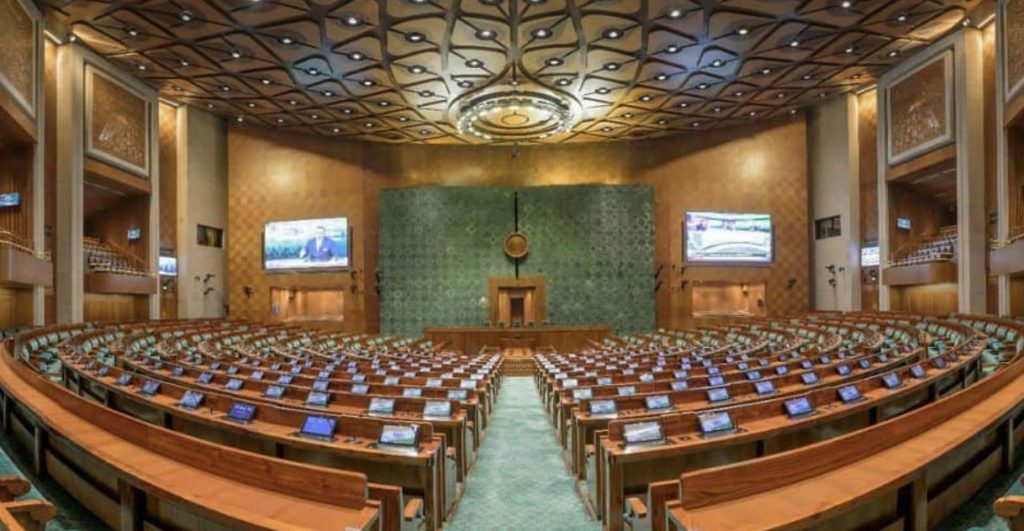The making of new Indian Parliament Building
Realizing People’s Aspirations
Mohammad Adnaan
The power of the Indian democratic system manifests in our Parliament, which weathered the Indian freedom struggle from colonial rule and witnessed many historical milestones. The existing building served as independent India’s first Parliament and witnessed the adoption of the Constitution of India. Thus, conserving and rejuvenating the rich heritage of the Parliament building is a matter of national importance.
An icon of India’s democratic spirit, the Parliament building sits at the heart of the Central Vista. India’s present Parliament House is a colonial-era building designed by British architects Sir Edwin Lutyens and Herbert Baker, which took six years to construct (1921-1927). Originally called the Council House, the building housed the Imperial Legislative Council. The Parliament building witnessed the addition of two floors in 1956 to address the demand for more space. In 2006, the Parliament Museum was added to showcase the 2,500 years of rich democratic heritage of India. The building had to be modified to a large extent to suit the purpose of a modern Parliament.
“India is the mother of democracy. It is also the foundation of global democracy. Democracy is our ‘Sanskaar’, idea & tradition,” Prime Minister of India Narendra Modi has said in his first address from India’s new Parliament building on May 28, 2023 in a ceremony which began with an early morning havan and multi-faith prayer ceremony.
Earlier, PM Modi installed the sacred ‘Sengol’ in the Lok Sabha chamber, right next to the Speaker’s chair, after performing puja. He was handed over the historic ‘Sengol’ by Adheenams before it was installed by the prime minister in the new Parliament building.
After initial deliberations about the shape of the building, a circular shape was finalised by both the architects, Herbert Baker and Sir Edwin Lutyens as that would give the feel of a colosseum design for the Council House. It is popularly believed that the unique circular shape of the Chausath Yogini temple in Morena, (Madhya Pradesh) had inspired the design of the Council House, though there are no historical proofs for this.
The Parliament House building construction was started in 1921 and commissioned in 1927. It is almost 100 years old and a Heritage Grade-I building. Over the years, the parliamentary activities and the number of people working therein and visitors have increased manifold. There is no record or document of the original design of the building. Therefore, the new constructions and modifications have been done in an ad-hoc manner. For example, two new storeys constructed in 1956 over the outer circular part of the building hid the dome of the Central Hall and changed the facade of the original building. Further, the coverings of Jaali windows have reduced the natural light in the halls of two houses of the Parliament. Therefore, it is showing signs of distress and over-utilization and is not able to meet the current requirements in terms of space, amenities and technology.
The present building was never designed to accommodate a bicameral legislature for a full-fledged democracy. The number of Lok Sabha seats has remained unaltered at 545 based on the delimitation carried out on the basis of 1971 Census. It is likely to increase substantially after 2026 as the freeze on total number of seats is only till 2026. The seating arrangements are cramped and cumbersome, with no desks beyond the second row. The Central Hall has seating capacity only for 440 persons. When the Joint Sessions are held, the problem of limited seats amplifies. Due to limited space for movement, it is also a huge security risk.
Over the period addition in services like water supply lines, sewer lines, air conditioning, fire-fighting, CCTV, Audio Video system, which were not originally planned, have led to seepages and destroyed the overall aesthetics of the building. The fire safety is a major concern as the building is not designed according to the present fire norms. Numerous new electric cables have been put up which are potential fire hazard.
The new building is triangular in shape, mostly because the plot of land that it is built on is a triangle. According to architect Bimal Patel, the shape is also a nod to the sacred geometry in different religions. Its design and materials are meant to complement the old Parliament, with the two buildings expected to function as one complex.
The new Parliament building has three storeys and a built-up area of 64,500 sqm. The Lok Sabha chamber will have 888 seats, up from the existing 543, with the option of expanded seating up to 1,272. The Lok Sabha will be used for joint sittings of both Houses in the absence of a Central Hall, which was the fulcrum of the old building.
The building has three ceremonial entrances on three sides for the President, the Vice-President, the Lok Sabha Speaker and the Prime Minister. The entrance for the public, including visitors for the Parliament tour, is likely to be on Parliament Street, near the Press Trust of India building, where a temporary reception has been functioning throughout the construction period.
Built using green construction techniques, the new building is supposed to reduce electricity consumption by 30 per cent, compared to the old one. Rainwater-harvesting and water-recycling systems have been included. It has been designed to be more space efficient, and meant to function for the next 150 years, according to the Ministry of Housing and Urban Affairs.
As per building codes, since Delhi is in seismic zone-V, the building is primed to be earthquake-safe. While arguing against the legal challenges to the project, the government had said the existing Parliament building was at risk from earthquakes.
The new Lok Sabha chamber has a peacock theme, with designs drawn from the national bird’s feathers carved on the walls and ceiling, complemented by teal carpets. The Rajya Sabha chamber has been decorated with the lotus as its theme, with red carpets. In both the Lok Sabha and the Rajya Sabha, two MPs will be able to sit on one bench and each MP will have a touch screen on the desk.
The Rajya Sabha chamber can accommodate 384 Members of Parliament (MPs), as opposed to the existing capacity of 250. The increased capacity of both chambers is meant to cater to any future increase in the number of MPs following delimitation.
For the interior and exterior of the building, construction materials have been brought in from across the country, including sandstone from Sarmathura in Dholpur and granite from Lakha village in Jaisalmer, Rajasthan. Similarly, the wood used in the decor is from Nagpur and craftsmen from Mumbai have led the wooden architecture design. Bhadohi weavers from Uttar Pradesh have made the traditional hand-knotted carpets for the building.
The 16-foot-tall bronze statue of Mahatma Gandhi, which has been the site of numerous protests and gatherings by MPs and photo-ops for students, will remain on the lawn between the old and new buildings. The statue, which was installed at the main entrance of the Parliament in 1993, was shifted during construction. Made by Padma Bhushan-awardee sculptor Ram V Sutar, the statue now faces the old building, near the entrance used by the Lok Sabha Speaker.
The building is replete with national symbols, including the national emblem — the Lion Capital of Ashoka — that weighs 9,500 kg and is 6.5 metres in height, and is visible from a distance. To support this massive bronze sculpture, a structure of 6,500 kg was constructed on top of the central foyer. At the entrance, the Ashoka chakra and the words ‘Satyameva Jayate’ have been carved in stone.
Before being selected as the site for the new Parliament building, the 9.5-acre plot opposite the old Parliament House was earmarked for “recreational use” in the Delhi Masterplan 2021. While it was supposed to be developed as a park, in reality the site was used for parking and to house utilities for the Parliament complex. The Delhi Development Authority changed the land-use of the plot to “Parliament House” in March 2020.
(The author can be mailed at madnaanmha@gmail.com)




